How Long Do Chameleons Live?


Written and verified by the biologist Cesar Paul Gonzalez Gonzalez
Chameleons are some of the most incredible reptiles in existence, as they have an extraordinary ability to change their color. This ability has made them popular as pets, as their peculiar appearances and diverse shades are famous all over the world. However, unlike other long-lived reptiles, chameleons live much shorter lives.
The average lifespan of a chameleon depends on the species, as some have very short lifespans. Also, even though it seems to be an easy reptile to take care of, many factors can further affect its survival. Read on and find out how long chameleons live.
How long do chameleons live?
In general, a chameleon has a life expectancy ranging from 1 to 20 years, which is a very large variation. As you can imagine, the fluctuation in the longevity of each specimen is due to different factors. In the case of captive animals, the following are very important determinants:
- Stress: This factor isn’t very evident, as chameleons don’t usually express their stress, but are only affected by its consequences.
- Reproduction: In the case of females, each reproductive event drastically decreases their longevity, so you should think carefully if you want your pet to reproduce. In addition, many of them lay infertile eggs even if they don’t reproduce.
- Food and hydration: The quality of their nutrition and hydration also has an impact on the life expectancy of these animals, so neglecting either of these two factors could be counterproductive.
It should be emphasized that stress greatly deteriorates a chameleon’s health, because, by reducing its defenses, it exposes it to other illnesses and diseases. This factor is a silent enemy, so the best way to combat it is to give your pet the right conditions. Remember that these organisms aren’t usually as sociable as other pets, so try to give them their space.
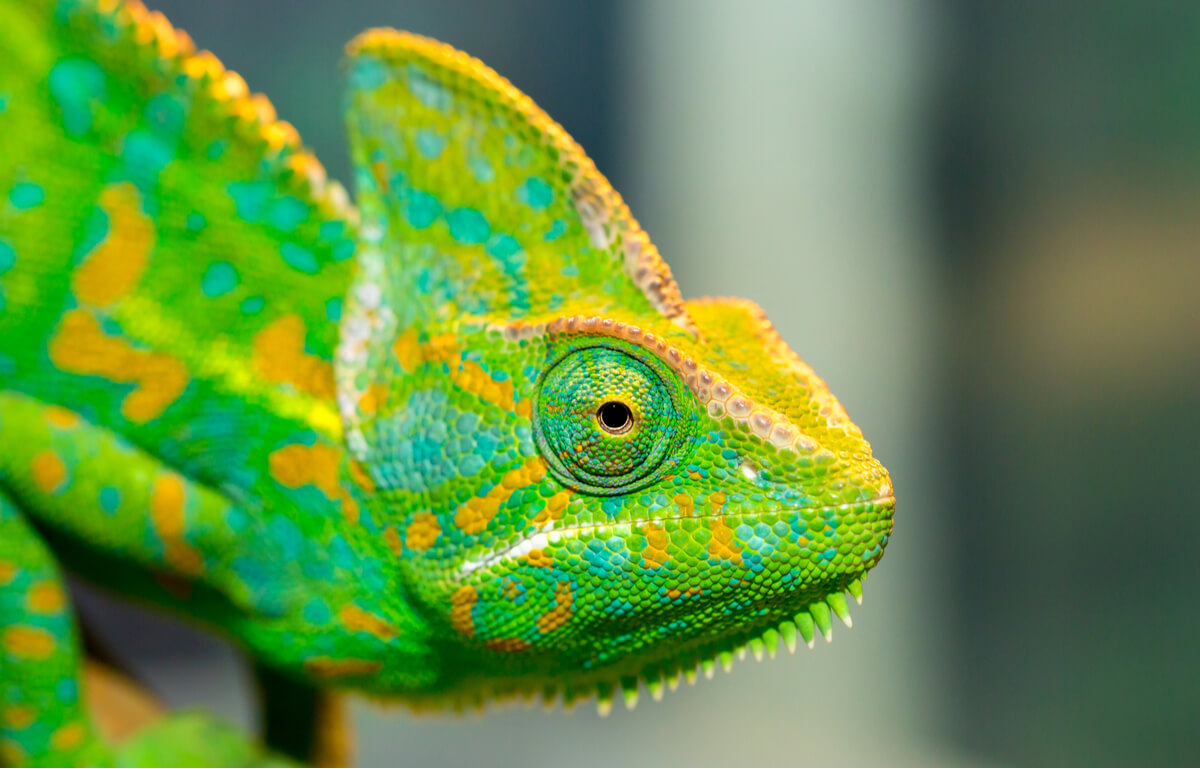
Life expectancy also depends on the species
However, all that we’ve mentioned so far doesn’t mean that any chameleon can reach 20 years of age. However, some can live longer with the necessary care. This is because the average lifespan also depends on the species we’re talking about. Here are some of the most popular specimens with their respective longevity.
Three-horned chameleon or Jackson’s chameleon (Trioceros jacksonii)
The three-horned chameleon, or Jackson’s chameleon, is a popular pet that measures between 15 and 25 centimeters long (6 to 10 inches), in addition to exhibiting beautiful horns. These reptiles belong to the African continent, where they occupy the humid forests of the region. In general, male specimens usually live about 10 years, while females only reach 5 or 6 years of age.
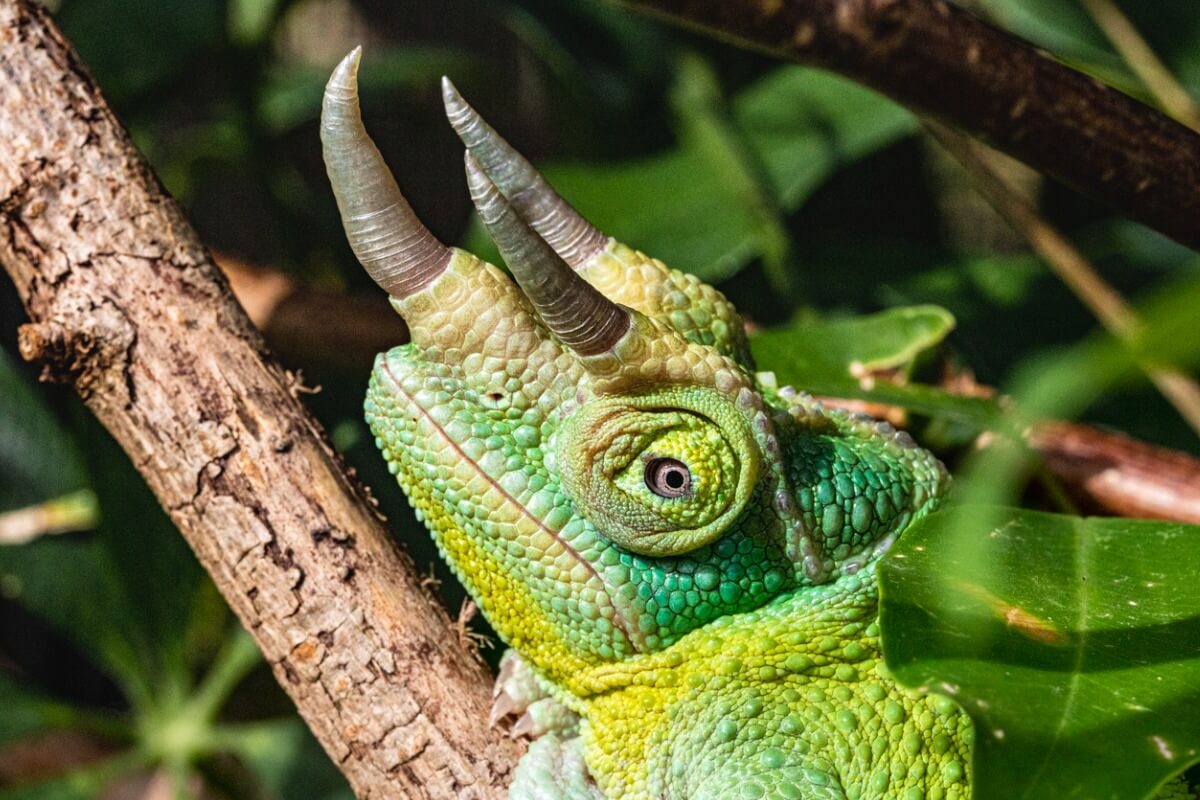
Four-horned chameleon (Trioceros quadricornis)
This species is a rare pet that usually measures between 25 and 35 centimeters (10 to 14 inches) in length. It’s native to Nigeria and Cameroon, where it inhabits very quiet forests far from urban centers. As for their life expectancy, females don’t live any longer than 5 years, while males reach a maximum of 7 years of age.
Pygmy chameleon (genus Rieppeleon)
These are some of the smallest chameleons that exist, reaching a maximum of 8 centimeters (just over 3 inches) in length. These animals aren’t very common as pets, as some countries require special documentation if you want to keep one. As for their longevity, males reach 3 years of age, while females barely reach a year.
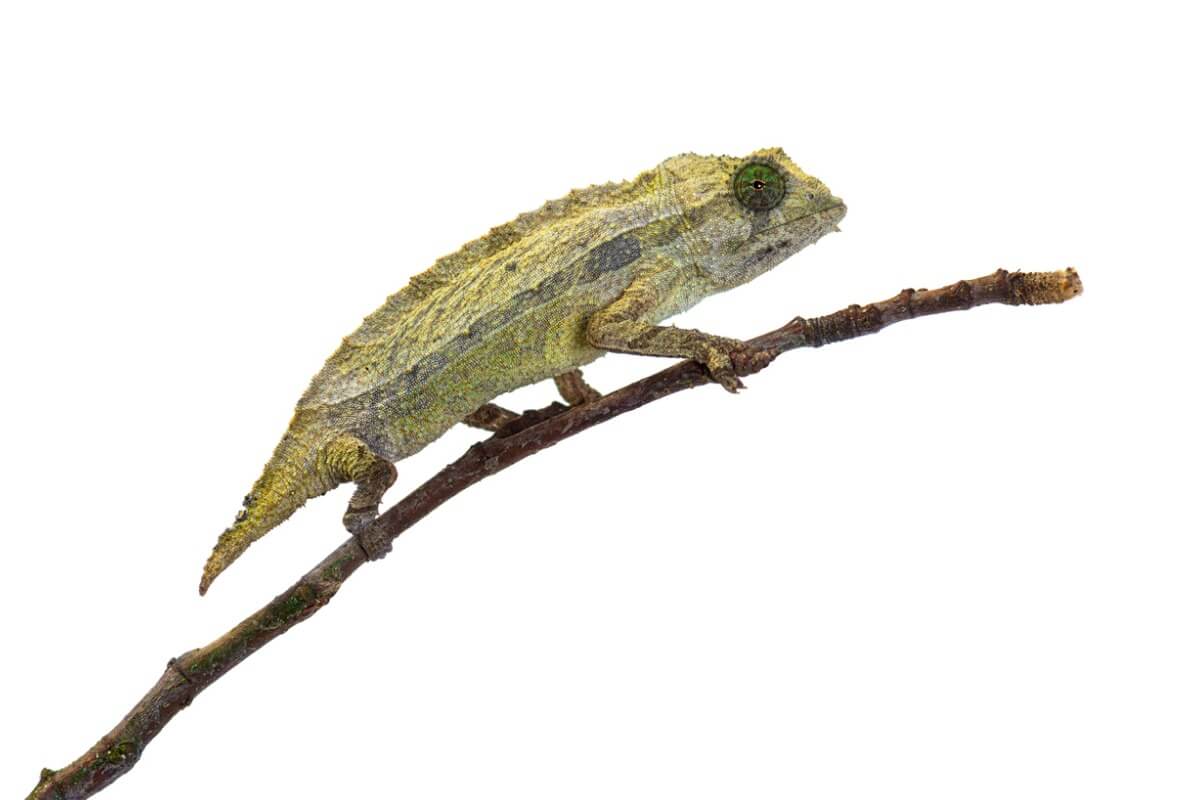
Labord’s chameleon (Furcifer labordi)
This specimen is endemic to Madagascar and can only be found in its natural habitat. It’s a very small animal, barely 10 centimeters (4 inches) long, and it has a fairly short lifespan. In fact, it’s considered the vertebrate with the shortest life expectancy, as it only lives for 4 to 5 months and dies shortly after breeding.
Parson’s chameleon (Calumma parsonii)
This species has a length of 80 centimeters (32 inches), making it one of the largest chameleons in existence. Thanks to its size, it’s often considered an excellent pet for herpetology enthusiasts. The life expectancy of these specimens is around 15 years for males, while females only reach 8 years.
These chameleons are very long-lived compared to others.
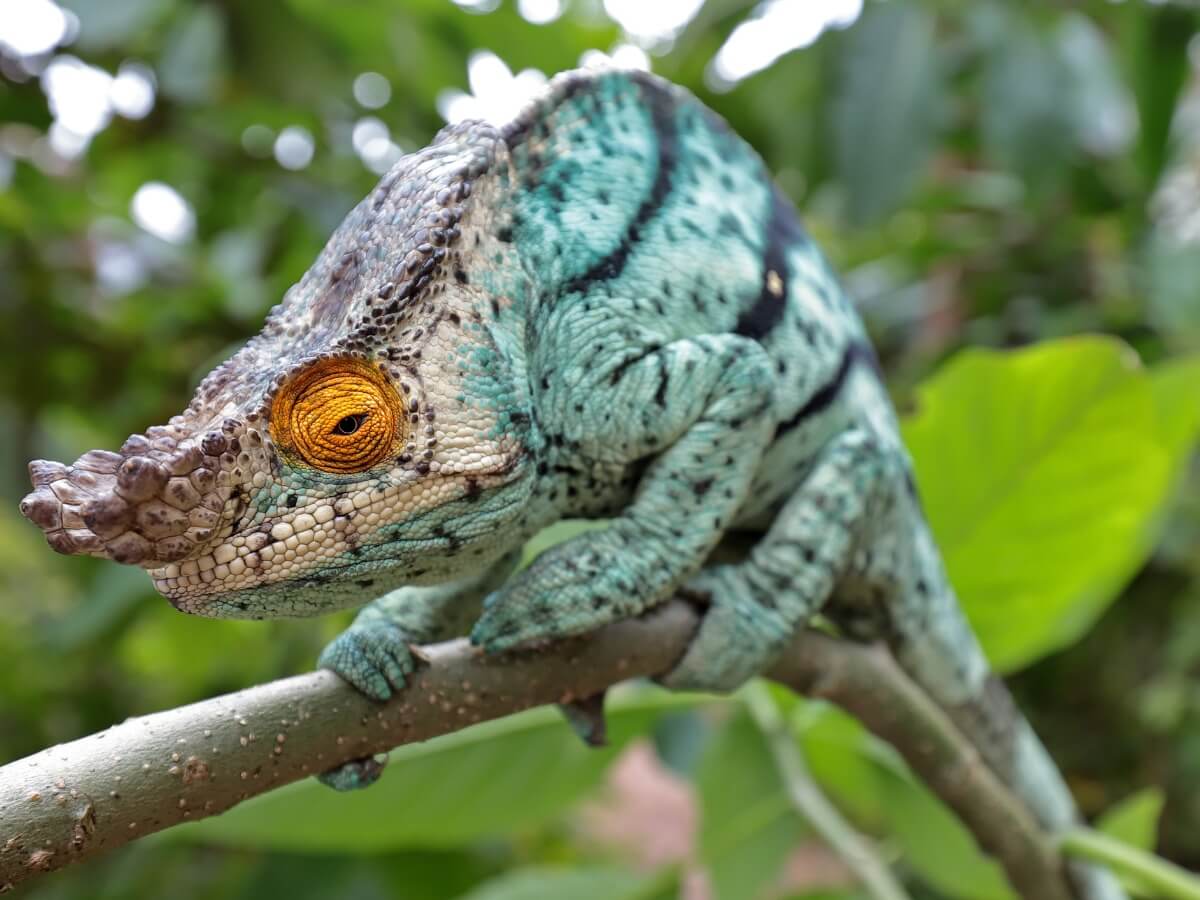
Yemen Chameleon (Chamaeleo calyptratus)
This chameleon is recognized by its crest that reaches 10 centimeters (4 inches) high, while its body is 45 centimeters long (18 inches). This specimen tends to be one of the most popular pets, especially the males. Males live 6-8 years and females only live 4-5 years.

Why do some chameleons live longer than others?
Thanks to natural processes, each species has adapted its body to each of its environments. In this way, each type of chameleon has a different life strategy that gives it advantages in order to survive. This process dictates the physiological changes of all living things.
When talking about chameleons, the reason why some live longer than others is because of their specific reproductive strategy. The ones that reproduce at an early age live shorter lives, while those that reproduce at a later age live longer. The reasons behind these mechanisms are listed below:
- Early reproduction: In this strategy, the aim is to mature as soon as possible to reproduce, because it’s likely that, in their environment, there are threats that will be difficult to evade. Sensing that they don’t have long to live in the wild, these chameleons do everything to ensure the survival of their species.
- Late reproduction: In this group, there aren’t enough threats to put their population at risk, so these chameleons focus on developing their bodies, getting good nutrition, and producing good features. For this reason, they take longer to start their reproductive season, which lengthens their life expectancy.
Why do males live longer than females?
As mentioned above, the cost of reproduction is very high for females, as they have to provide all the nutrients that will feed their offspring. Mothers wear out their bodies with each reproductive event, which makes them weak and more susceptible to different diseases. For this reason, they live much shorter lives than males.
Do males have any disadvantages?
You may think that females do all the work, as their mates don’t seem to contribute much. This isn’t the case, as the males go through some difficulties that also affect their daily life. The male invests energy and nutrients in the development of his body and has to fight against others for the right to mate (sexual selection).
At first glance, although it may not seem to be of great importance, such battles have a high energetic cost for these animals. In addition, during these conflicts, they may be injured, which, in some cases, costs them their lives. At the end of the day, reproduction also affects the male in a certain way, as he has to “compete” in order to reproduce.
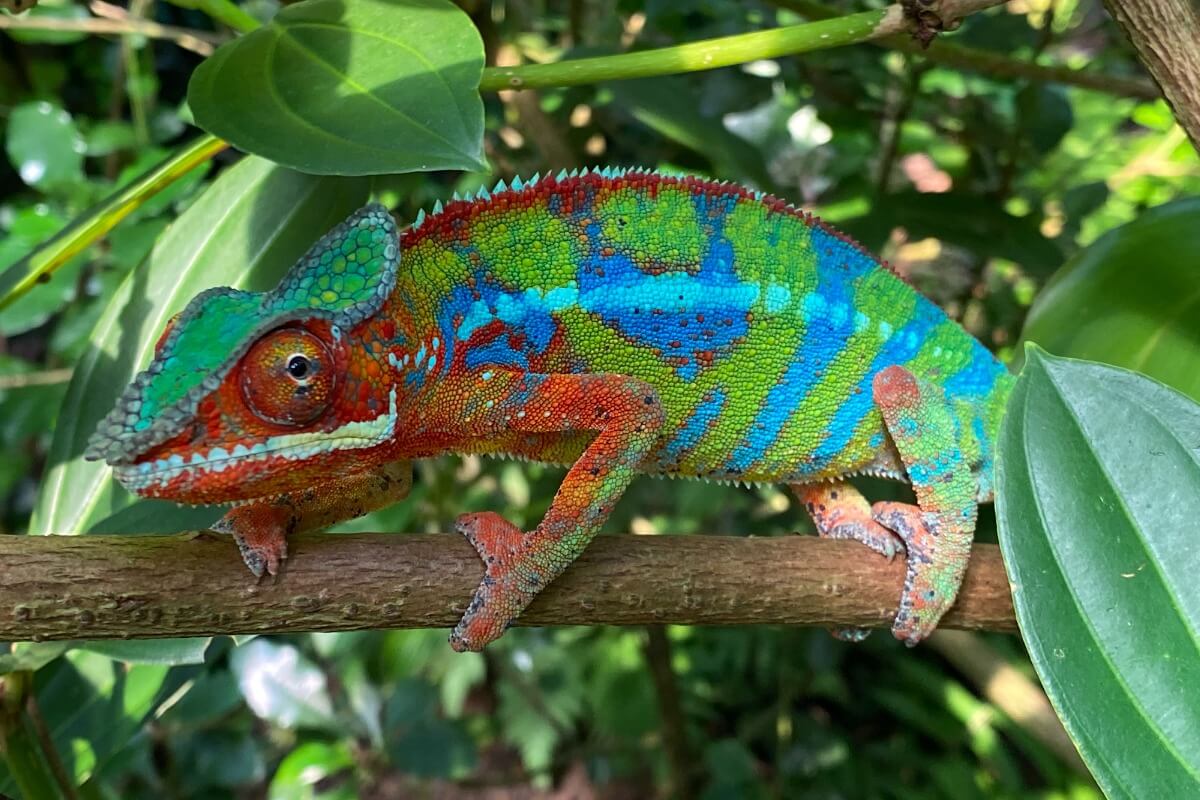
The life expectancy of chameleons is closely related to their natural history. This is because all their characteristics have a function in their habitat, as they’re the result of a process of natural selection. The simple fact that some species live longer than others is another sign of the natural processes that change and modify animals.
Chameleons are some of the most incredible reptiles in existence, as they have an extraordinary ability to change their color. This ability has made them popular as pets, as their peculiar appearances and diverse shades are famous all over the world. However, unlike other long-lived reptiles, chameleons live much shorter lives.
The average lifespan of a chameleon depends on the species, as some have very short lifespans. Also, even though it seems to be an easy reptile to take care of, many factors can further affect its survival. Read on and find out how long chameleons live.
How long do chameleons live?
In general, a chameleon has a life expectancy ranging from 1 to 20 years, which is a very large variation. As you can imagine, the fluctuation in the longevity of each specimen is due to different factors. In the case of captive animals, the following are very important determinants:
- Stress: This factor isn’t very evident, as chameleons don’t usually express their stress, but are only affected by its consequences.
- Reproduction: In the case of females, each reproductive event drastically decreases their longevity, so you should think carefully if you want your pet to reproduce. In addition, many of them lay infertile eggs even if they don’t reproduce.
- Food and hydration: The quality of their nutrition and hydration also has an impact on the life expectancy of these animals, so neglecting either of these two factors could be counterproductive.
It should be emphasized that stress greatly deteriorates a chameleon’s health, because, by reducing its defenses, it exposes it to other illnesses and diseases. This factor is a silent enemy, so the best way to combat it is to give your pet the right conditions. Remember that these organisms aren’t usually as sociable as other pets, so try to give them their space.

Life expectancy also depends on the species
However, all that we’ve mentioned so far doesn’t mean that any chameleon can reach 20 years of age. However, some can live longer with the necessary care. This is because the average lifespan also depends on the species we’re talking about. Here are some of the most popular specimens with their respective longevity.
Three-horned chameleon or Jackson’s chameleon (Trioceros jacksonii)
The three-horned chameleon, or Jackson’s chameleon, is a popular pet that measures between 15 and 25 centimeters long (6 to 10 inches), in addition to exhibiting beautiful horns. These reptiles belong to the African continent, where they occupy the humid forests of the region. In general, male specimens usually live about 10 years, while females only reach 5 or 6 years of age.

Four-horned chameleon (Trioceros quadricornis)
This species is a rare pet that usually measures between 25 and 35 centimeters (10 to 14 inches) in length. It’s native to Nigeria and Cameroon, where it inhabits very quiet forests far from urban centers. As for their life expectancy, females don’t live any longer than 5 years, while males reach a maximum of 7 years of age.
Pygmy chameleon (genus Rieppeleon)
These are some of the smallest chameleons that exist, reaching a maximum of 8 centimeters (just over 3 inches) in length. These animals aren’t very common as pets, as some countries require special documentation if you want to keep one. As for their longevity, males reach 3 years of age, while females barely reach a year.

Labord’s chameleon (Furcifer labordi)
This specimen is endemic to Madagascar and can only be found in its natural habitat. It’s a very small animal, barely 10 centimeters (4 inches) long, and it has a fairly short lifespan. In fact, it’s considered the vertebrate with the shortest life expectancy, as it only lives for 4 to 5 months and dies shortly after breeding.
Parson’s chameleon (Calumma parsonii)
This species has a length of 80 centimeters (32 inches), making it one of the largest chameleons in existence. Thanks to its size, it’s often considered an excellent pet for herpetology enthusiasts. The life expectancy of these specimens is around 15 years for males, while females only reach 8 years.
These chameleons are very long-lived compared to others.

Yemen Chameleon (Chamaeleo calyptratus)
This chameleon is recognized by its crest that reaches 10 centimeters (4 inches) high, while its body is 45 centimeters long (18 inches). This specimen tends to be one of the most popular pets, especially the males. Males live 6-8 years and females only live 4-5 years.

Why do some chameleons live longer than others?
Thanks to natural processes, each species has adapted its body to each of its environments. In this way, each type of chameleon has a different life strategy that gives it advantages in order to survive. This process dictates the physiological changes of all living things.
When talking about chameleons, the reason why some live longer than others is because of their specific reproductive strategy. The ones that reproduce at an early age live shorter lives, while those that reproduce at a later age live longer. The reasons behind these mechanisms are listed below:
- Early reproduction: In this strategy, the aim is to mature as soon as possible to reproduce, because it’s likely that, in their environment, there are threats that will be difficult to evade. Sensing that they don’t have long to live in the wild, these chameleons do everything to ensure the survival of their species.
- Late reproduction: In this group, there aren’t enough threats to put their population at risk, so these chameleons focus on developing their bodies, getting good nutrition, and producing good features. For this reason, they take longer to start their reproductive season, which lengthens their life expectancy.
Why do males live longer than females?
As mentioned above, the cost of reproduction is very high for females, as they have to provide all the nutrients that will feed their offspring. Mothers wear out their bodies with each reproductive event, which makes them weak and more susceptible to different diseases. For this reason, they live much shorter lives than males.
Do males have any disadvantages?
You may think that females do all the work, as their mates don’t seem to contribute much. This isn’t the case, as the males go through some difficulties that also affect their daily life. The male invests energy and nutrients in the development of his body and has to fight against others for the right to mate (sexual selection).
At first glance, although it may not seem to be of great importance, such battles have a high energetic cost for these animals. In addition, during these conflicts, they may be injured, which, in some cases, costs them their lives. At the end of the day, reproduction also affects the male in a certain way, as he has to “compete” in order to reproduce.

The life expectancy of chameleons is closely related to their natural history. This is because all their characteristics have a function in their habitat, as they’re the result of a process of natural selection. The simple fact that some species live longer than others is another sign of the natural processes that change and modify animals.
All cited sources were thoroughly reviewed by our team to ensure their quality, reliability, currency, and validity. The bibliography of this article was considered reliable and of academic or scientific accuracy.
- Eckhardt, F., Kappeler, P. M., & Kraus, C. (2017). Highly variable lifespan in an annual reptile, Labord’s chameleon (Furcifer labordi). Scientific reports, 7(1), 1-5.
- Karsten, K. B., Andriamandimbiarisoa, L. N., Fox, S. F., & Raxworthy, C. J. (2008). A unique life history among tetrapods: an annual chameleon living mostly as an egg. Proceedings of the National Academy of Sciences, 105(26), 8980-8984.
- Eckhardt, F., Kraus, C., & Kappeler, P. M. (2019). Life histories, demographies and population dynamics of three sympatric chameleon species (Furcifer spp.) from western Madagascar. Amphibia-Reptilia, 40(1), 41-54.
- Kieselbach, D., Müller, R., & Walbröl, U. (2007). Camaleones. Editorial HISPANO EUROPEA.
- Karsten, K. B., Andriamandimbiarisoa, L. N., Fox, S. F., & Raxworthy, C. J. (2009). Sexual selection on body size and secondary sexual characters in 2 closely related, sympatric chameleons in Madagascar. Behavioral Ecology, 20(5), 1079-1088.
This text is provided for informational purposes only and does not replace consultation with a professional. If in doubt, consult your specialist.








